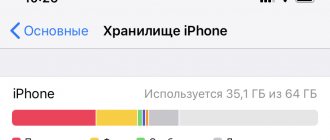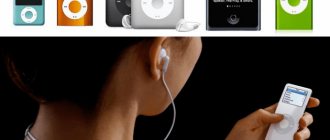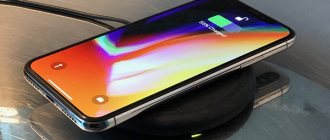We picked up our iPhone 5s on the second day after sales started and decided not to rush anywhere. They turned it, twisted it, tested it. This is a review of the 16GB white version. Go!
Buy an iPhone for 20 thousand cheaper than the market here. They change something and even give it away for free.
It seemed that the standard Apple product update cycle had already become obsolete. When competitors capture an increasing share of the market, Cupertino consistently sticks to its line and pretends not to notice anything. This is not at all true - and the fact that we saw the announcement of the iPhone 5c says a lot about the company’s attempt to adapt to new realities and market challenges.
iPhone 5s is a real upgrade compared to the previous generation of Apple smartphones, which appeals to a much larger number of potential buyers. There is a new gray and black variant, as well as two new white ones - one of them is “gold”. Buying one, regardless of the country, on the day sales started was akin to incredible luck, but white devices soon became scarce in many stores. They brought us exactly the white one, and Arthur and I, being the owners of white iPhone 5, were only happy about it.
This is what the kit of the new smartphone looked like. Everything is as usual: charger, Lightning cable, Earpods with microphone and volume control, a clip for the SIM card tray and a few reference papers. The main thing is the iPhone 5s itself.
A person far from the world of technology will take a look at the 5s and conclude that it is an exact copy of the iPhone 5. In principle, it is difficult to argue with this. Still the same wonderful and thin metal body with two glass panels at the bottom and top. An elongated profile and a minimalist front panel that frames the 4-inch display. The formula “don’t touch it while it’s working” played to its fullest here, and it would not be very reasonable to blame Apple for this. But I want to.
In fact, the difference between the iPhone 5 and iPhone 5s is noticeable from all sides and edges, except the very bottom. The first thing that caught my eye was the new design of the volume and lock buttons. In the iPhone 5, their installation location was framed by a recess slightly larger than the key itself. Because of this, after a month or two, dirt and dust would accumulate there, no matter how carefully you handled the phone. In the iPhone 5s, these buttons seem to be “stuck” on top of the body. The advantages of the solution, I think, are clear to everyone, but there can be no disadvantages here: these buttons are pressed in exactly the same way as before. We also felt that the color of the SIM card tray matches the color of the body much more closely than before. But we were unable to capture this in a photograph, since the difference is visible only in dynamics.
All “s” series smartphones to some extent corrected the design and visual shortcomings of previous models. This is true. According to rumors, Apple has changed its body painting technology to minimize the problem of paint rubbing off the edges of the device. It is likely that it was because of this that the infamous black version of the smartphone disappeared from sale. The white one was not subject to this problem and therefore became a real alternative even for those who previously considered it exclusively feminine: after six months of active use, a black iPhone looks disgusting, and it is better to go with a white one, but “perfect” in appearance, than with a black and as if killed “in the trash.” One way or another, the white models 5 and 5s match the shade of the metal of the body entirely.
Another visual modification is a new camera-microphone-flash unit on the rear panel. The camera, for example, has lost its shiny rim, and now its protective glass occupies the entire “groove” on the back. The hole for the microphone changed its shape from a “pill” to a regular hole-point. But the flash has become “oval”: now there are two LEDs of different light temperatures, which adjusts the color of the photo to a more realistic one, especially if there are faces in the frame.
Finally, the permanent “iPhone” text on the back panel is now written in Helvetica Neue font with an Ultra Light style. Particularly impressionable owners upgrading from iPhone 5 will have to get used to the new state of affairs - and to iOS 7, from where this font became widespread.
No one believed in the prospect of a 64-bit processor appearing in the iPhone 5s. And here we are holding it in our hands, managing a 64-bit operating system and 64-bit applications. If you think that the transition to a new bit depth has changed something, I hasten to disappoint: iOS 7 on the “esque” looks exactly the same as on the regular “five”. System programs like Weather open and load somewhere between 25 and 35 percent faster, but overall don't show a really big boost in visible performance. That's because the iPhone 5 still works fine with iOS 7, and the difference between 15 milliseconds and 25 isn't significant enough for 99% of users. The only exception is Safari, which opens pages at least a third faster. This is especially noticeable on “heavy” sites with complex layout and a large number of images.
Under the metal hood of the iPhone 5s there is a dual-core A7 processor with a frequency of 1.3 gigahertz, 1 gigabyte of RAM, a new additional M7 chip for processing data about the device’s position in space, and a very powerful three-core PowerVR Series 6 “Rogue” video processor. Which of the above actually tells you something? Most likely, only the size of the RAM: it has not changed since the iPhone 5, which is a little disappointing.
Otherwise, iPhone 5s owners can safely shove their device in the faces of owners of absolutely all other mobile devices, especially those running Android OS. According to the results of numerous tests, the dual-core A7 processor beats all existing and marketed analogues for mobile devices. Even Samsung's 4-core designs do not provide the same performance on the system. Simply put, this is one of the most powerful mobile gadgets today: only the new LG G2 smartphone can compare with it, and sometimes not in favor of the latter. By the way, Infinity Blade III really works better on the iPhone 5s, but the long loading bug, which was “cured” on iOS 7, has not been resolved on iOS 7.0.1, which was released specifically for the iPhone 5s and 5c. But how beautiful this game looks! Screenshots are clickable:
iPhone 5
iPhone 5s
How do innovations affect the operation of the operating system? Today, in the fall of 2013, almost nothing. But only today. This story repeats itself year after year. There's a new iPhone model coming out that's a little faster than the old one. Over the next 12 months, new firmware, new features and new applications will appear, increasingly demanding on performance. By the day the next Apple smartphone model is released, the difference in real performance between the iPhone 5 and iPhone 5s will definitely be much greater. And then the 5s slogan, “thinking ahead,” begins to sound noticeably more interesting.
64-bit architecture does not play such a big role in the performance of devices until they have a large amount of RAM - from 4 gigabytes. But now developers are forced to adapt their new projects to a new processor - which means the difference in the capabilities and speed of programs and games may become more noticeable. Adaptation lies solely on the shoulders of each developer, and until the most famous programs are rewritten for the new processor, the advantages of the new hardware will be truly noticeable only in synthetic tests, “benchmarks”. All this means that when buying an iPhone 5s to replace the iPhone 5, you are primarily investing in a bright future and maximum iOS performance for a year or two ahead.
But it's much more likely that you actually just want to poke at the Touch ID sensor
We tested. iPhone 5s does not work in Russian lte networks. This does not depend on the model number and country of origin of the iPhone. Apparently, Apple blocked this opportunity for Russia for reasons only known to it, although in the specifications on the Apple.com website the operating frequency numbers coincide with ours.
In our harsh opinion, you can upgrade from iPhone 5 to iPhone 5s solely because of the new camera. We will omit the technical details, because most owners will not be interested in them. It’s better to pay attention to an absolutely indisputable fact: the 5s takes pictures in the dark much, MUCH better than all previous iPhones. Left iPhone 5, right iPhone 5s:
The difference is amazing: where the “five” turns the black sky into a dance of multi-colored pixel artifacts, the “eska” shows a truly black color without interference that spoils the final photo. This is the advantage of a larger camera sensor, and, unlike the mindless race for megapixels, this approach really deserves respect. Remember how many of your photos were taken in low light conditions - evenings at home, cafes and clubs with dim lights, food in a restaurant and the faces of cats indoors. Now all this will look better not only on Instagram and Vkontakte, but also simply on the screen, computer, and especially on paper. And if you remember that the new camera is capable of shooting video with a “time slowdown” effect...
The dual flash did not leave any lasting impressions, because the difference in photos with it turned out to be small under normal shooting conditions. It works best if there are people in the frame: skin color looks more realistic because the iPhone 5s pre-adjusts the color of the flash to what is happening in the frame. But ordinary shots, for example, of objects, look exactly the same with the new flash. But having a feature is always better than not having it. And if you are planning to photograph people against the backdrop of night cities, the only thing that can compete with the iPhone 5s is the newest Nokia Lumia 1020. Considering that its camera is considered the best among smartphones, this was a very serious compliment. And if you remember the size of this same camera and compare it with that in the iPhone, then Apple can generally be proud of itself.
iPhone (2007)
The first iPhone was innovative in its own right.
Restrained design, a minimum of elements on the body, a strict front panel. Remember what smartphones looked like before the advent of the iPhone: protruding antennas, joysticks, a bunch of buttons under the screen (sometimes even above it), styluses, a sliding qwerty keyboard and indecent thickness. Now look at the windows of any electronics store. Most of the devices are very similar to what Steve Jobs showed off on January 9, 2007.
The company showed what Apple smartphones would look like in the next few years, and subsequently followed the laid down principle.
What was upsetting: unfortunately, there are no drawbacks, the first generation iPhone did not receive a number of functions that competitors had (3G support, video recording, multitasking, etc.), the operating system was closed to the user, there were many Apple restrictions ( You cannot transfer pictures and music to other users, limited support for data formats, download files only through iTunes).
The big problem was that the headphone jack was too deep, which did not allow the use of many 3.5 mm headsets.
iPhone 3G (2008)
The smartphone began to acquire functions, primarily due to the update of the mobile operating system. In iOS 2.0 we saw the App Store. Since then, third-party developers have been able to earn money from us by releasing applications for the iPhone. At the last presentation, Tim Cook reported on more than 2 million applications in the store.
And with the release of the iPhone 3G, we saw support for UMTS, HSDPA, A-GPS and different body colors (black and white).
What upset me: the plastic case and its low wear resistance. After just a few months, the back panel was covered with scratches, cracks appeared near the cable connector, and pieces even broke off during active use.
iPhone 3GS (2009)
In 2009, we first learned that Apple wasn't going to update the design every year. After that, in odd-numbered years, “eski” began to be released with last year’s design, but new hardware.
The model was remembered for the appearance of a camera with autofocus and the ability to shoot video. For the first time, the iPhone received a digital compass. Of the software innovations, multitasking and voice control (Voice Control) should be noted.
What upset me: old design.
iPhone 4 (2010)
With this model we learned about a high pixel density screen - Retina Display. After holding such a device in my hands for 5 minutes, I didn’t want to use previous generation screens. Until now, a pixel density of over 300 per inch is considered the standard. The technology began to be used not only in the iPhone, it appeared on Apple tablets and computers.
The device is also memorable for its front camera, LED flash and gyroscope.
What was upsetting: antennagate became a big failure for Apple. With a certain grip, the iPhone 4 lost the network and this was widespread. Jobs and company had to apologize and hastily “invent” bumpers.
Appearance.
The iPhone 5s, which just recently hit retail stores, is very similar to its predecessor. Almost everything it contains is a duplicate of the popular iPhone 5. Let’s look at the differences, which, upon closer examination, turn out to be significant. The weight of the device remained unchanged, the same dimensions, the same monolithic feeling when you hold the gadget in your hand. Connectors and buttons occupy the same places. It is worth noting, however, that the creators made sure that the holes for the buttons were made more accurately. Over time, the buttons will not become loose, which, naturally, is good news. Previously, service center employees received questions from their clients asking about the nature of the origin of the rattling sound inside the iPhone during the shaking process. The explanation that clients received was quite simple - the buttons, moving inside their grooves, produced a similar sound. Most likely, Apple employees were asked similar questions more than once, so the company's engineers found a way to correct the situation.
iPhone 4s (2011)
The main innovation of the last smartphone released under Jobs (the event was hosted by Tim Cook, and Steve died the day after the presentation) was the Siri voice assistant.
Then the feature seemed unsuitable for use. Later, Siri learned a number of commands, learned several poems and jokes, and even mastered the Russian language.
The iPhone itself was able to distribute the Internet via Wi-Fi, shoot Full-HD video, and broadcast images via AirPlay. The developers also combined GSM and CDMA models in one device.
What was upsetting: the lack of support for the Russian language in Siri.
iPhone 5 (2012) [Our review]
In 2012, we learned that Apple could produce a device with a screen diagonal larger than 3.5 inches. The 30-pin connector is retired, replaced by Lightning, which is with us to this day.
With this model, many first learned about the nano-Sim format (remember how you cut your cards with scissors?) and the EarPods headset.
What was upsetting: strange paint on the back panel, which quickly peeled off.
iPhone 5s (2013) [Our review]
This device has a Touch ID fingerprint scanner. It's hard to imagine how much time these sensors save us every day. Instead of entering a long password, simply use your finger.
iPhone 5s was the first Apple smartphone to be released in gold.
We will not consider the iPhone 5c model. Apple went for an experiment that was never repeated; the device had no innovations, but was only a cheaper copy of the iPhone 5 in a colored plastic case.
What was upsetting: a 64-bit processor and 32-bit applications; the App Store was not ready for the release of a model with a new processor. Until developers adapted programs and games, many 32-bit applications performed worse on the iPhone 5s than on the iPhone 5.
Contents of the box.
Just like any theater starts with costumes, the iPhone presentation starts with the box. The contents remain the same - EarPods in a plastic case, the same USB-lighting cable, 5 W charging, a paperclip that users recognize from the time of the release of the first iPhone, an instruction manual, as well as stickers with the Apple logo on them. The box itself has changed somewhat. The size remains the same, but the external design has been adjusted. The company's design team decided to return the dominance of white, as was the case with the iPhone 4S.
The front side looks like the first models - iPhone, iPhone 3G and iPhone 3GS
The top cover is decorated with front-facing shots of the iPhone in gray, gold, or silver, depending on the color of the device inside. The photo shows an iPhone with the screen turned on. This picture is much more logical, because previously users were wary when observing the “perspective” view of previous versions of the iPhone on the lid of the box. To put it simply – “Back to Basics”. On the sides the box is decorated with the inscriptions “iPhone 5s” and the Apple logo, which are made in the same color (black, silver or gold) as the mobile device inside. In the complex, everything looks quite elegant and tasteful.
iPhone 6/6 Plus (2014) [Our review]
In 2014, we saw the first “shovels” from Apple. Two years later we got used to this size of the smartphone, but then it was too much.
Thin body, powerful hardware, camera with Full HD shooting at 60 frames per second and optical stabilization (in the Plus model).
What's upsetting: we haven't forgotten Apple's advertising with the ideal screen size for a smartphone. And for the first time we saw iPhones being bent en masse.
Moments that shouldn't scare you
If, when turned on, the smartphone does not request activation, then this may have been done by the first owner or seller. The information should be clarified. The amount of memory may vary - depends on the modification, but not less than 16 GB.
The relatively low price should not be alarming if the smartphone is purchased second-hand, but it is worth checking the iPhone carefully.
iPhone 6s/6s Plus (2015) [Our review]
Last year's new products include a pressure-sensitive screen with 3D Touch and software innovations associated with the use of this technology. There was also a new color “rose gold”.
What was disappointing: too little innovation and software features of dubious benefit (“live” photos, pop-up menus).
There was also a “tuned” iPhone 5S with the clever name “SE” (who forgot, here’s its review), but the model can hardly be called innovative. The device did not bring anything new to the line, although it became the most powerful 4-inch smartphone on the market.
Energy efficiency
If we take into account the high-speed features and guaranteed LTE, which is planned in Russia, it may seem that the iPhone 5s battery will only last for 3-4 hours of operation. We hasten to refute this opinion. It is claimed that users with the iPhone 5s will have access to 250 hours of standby time, 10 hours of voice communication, and 40 hours of music playback.
This information is taken from artificial tests that are almost impossible to implement in real life. It is difficult to imagine, for example, a conversation lasting 10 hours or 2 days of tireless listening to music.
A full iPhone charge is enough to use it in active mode for a whole day or in relaxed mode, without calls after 30-40 minutes and tirelessly playing Angry Birds.
iPhone 7/7 Plus (2016) [Our review]
This year, the iPhone stopped being afraid of water, began to use battery power more wisely, and began to produce stereo sound. A rather controversial decision was the abandonment of the 3.5 mm jack. Now headphones are only Bluetooth or Lightning.
And in the line there are as many as 5 body colors, this has not happened since the iPhone 5c.
What was upsetting: the virtually unchanged design and scratchy “black onyx”, which is impossible to buy.
Now try to remember how you reacted to the innovations of each model when it appeared. No one ran headlong for the iPhone just because it had 3G or LTE support, a front camera or flash, Siri or a big screen. At the time these features appeared, many people thought they were unnecessary, but now we use them several times a day.
From year to year, everyone expects a revolution from Apple, demanding a holographic screen and teleport in the iPhone, while they themselves silently use the company’s technology. None of the features of previous smartphones have lost their relevance over several years; they fit harmoniously into our use case.
The same thing will happen with the misunderstood 3D Touch, and with the moisture protection of the case, and with the lack of a 3.5 mm jack. Remember my words in a few years.
Stop thinking that Apple is stupid and that we know better what the iPhone should be. A smartphone should be exactly what it is. Whoever is not satisfied with this, welcome to the club of the thinker Grisha.
PS: write in the comments which iPhone you started with. And what we were left with in the end.
( 43 votes, overall rating: 4.58 out of 5)











